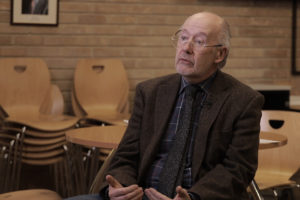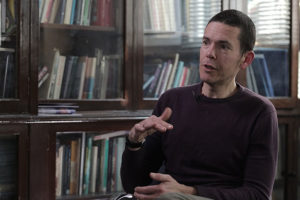Global Architecture History
Professor Mark Jarzombek on what Buddhist temples express, transfer of architectural techniques, and the Euroc...
It’s difficult to actually render the complexity of the history of medieval mapmaking. Basically because we are not left with all the artifacts, so we presume that what we have is representative of what happened then. There were different kinds of mappings. Certainly the most striking was the tradition of the medieval «Mappa Mundi». «Mappa Mundi» is a Latin expression literally means ‘cloth of the world’. «Cloth» because the world was painted on a cloth, on a mappa, on a map. These were the English word «map» comes from. It was painted, it was depicted on a surface. Then I will have to describe maps that I think you can imagine.
But what is interesting is that even though that this world was painted on a flat surface, people in the Middle Ages knew very well that the world was a sphere, was a globe. This is one of the most misleading prejudices of modern historians, who thought to dismiss the predecessors, because they were ignorant. And then this legend, which is a 19th century legend, that even Christopher Columbus thought that the world was flat. This is rubbish, they knew very well from Aristotle, from Greek science that the world was a sphere. So what you find in this medieval mappa mundi is just a portion of the sphere. It looks flat only because it was rendered on a flat surface, but what you find in a medieval mappa mundi, in a medieval map of the world, is just the representation of the northern hemisphere. And the northern hemisphere according to medieval scientists was composed of three parts: Europe, Africa, and Asia.
Of course, these maps were not only geographical facsimile of the Earth as our own maps, but they rendered human history. This is perhaps even more scientific than are our own maps. In the Middle Ages they knew very well what we are told now by, especially, 20th century physicists that you can’t satellite time and space, they are joined together. We can’t think of a place without attaching a time to it. It is perhaps very modern cartography, recent cartography is catching up the Middle Ages’ intuition we know with animated cartography, digital photography, time is getting back into the map. But this is the very first thing that should teach us to be more respectful of our own past. In the Middle Ages they knew very well what they were they doing.
They knew, for example, that time and space were intrinsically joined together. The other thing which is perhaps impressive for a modern onlooker on medieval maps is that maps were orientated with the East at the top. Pretty often when I show these medieval maps, people say, “Oh, this is wrong! The North is there.” No, it’s just that is oriented in a different way. Orientated, «oriens» is the Latin word for East, because East is at the top; East is at the top because the sun rises in the East.
An interesting feature that distinguished Medieval mapping from modern mapping, something that they would explain to a modern onlooker to a medieval Mappa Mundi, is that for medieval mapmakers direction, proportion, exact distance were not important. You wouldn’t judge a map as distorting features, not exact because this was not their concern. What their concern was was just to show that a place was contiguous to another place. Historians talk about topological approach. Medieval mappa mundi would show you just that India was East of Persia, Persia was east of Greece, but they were not concerned to show you exactly. This came later with the nautical cartography and with the ptolemaic cartography.
It is true, however, that medieval mappa mundi was not the only kind of maps circulating in the Middle Ages. They were zonal maps already in the 10th century, but this was another kind, another genre of mapmaking. Maps which were not based on history as the medieval mappa mundi, which included human history as displayed on the stage of geography. These zonal maps represented the globe (again, another hint that they perfectly knew that the Earth was a globe) as divided into climatic zones, following Greek science. So according to astronomical criteria the torrid zone was in the middle, two temperate zones in the northern and in the southern hemisphere, and the two very cold polar zones.
Usually you find this network of very important, I would call them, place events. Places where important events in human history took place. For example, you have at the top of the Garden of Eden, because it is in the far East. Then you go down, very often, for example, in Hereford Map, we find Enoch, which is the very first city founded by man according to the Bible. When you keep going down, in other words, westwards, you may come across the Tower of Babel, for example. Then you can come across important event places – so important, I would say, chronotopal, epochal zones, for example, the Persian Empire, Greece and then Rome. You have in the representation of the Mediterranean basis the mixture of past and present. You still read in the Middle Ages names of the Roman provinces, and you have also modern emporia like Genuine, for example. You come across Rome.
Of course, the most detailed part of this mappa mundi was Europe and the lands near to the cartographer. The representation would end at the bottom with the western edge of the Mediterranean and the Pillars of Hercules. The Pillars of Hercules is where the end of the world is. Other examples include the Ebstorf Map. The Ebstorf Map is a beautiful map, unfortunately, destroyed during Second World War in Hanover. The Ebstorf Map has amazing iconography, we were left with very detailed photographs. And we see this very detailed representation of the Earth on which a gigantic figure of Christ is superimposed. Christ has the head in the Far East, the two arms outstretched, and two hands are in the extreme North and in the extreme South, and his feet are in the extreme West. At the center is again Christ represented as rising from his tomb in Jerusalem.
But this is not all of it. This map is so detailed and full of stories in a different way. Another series is the corpus called the Beatus Map. These are very early Maps attributed by monk Beatus began in the 8th century Spain are very interesting because they are completely different style. You find paradise very prominently represented in the east, so there are many examples of this kind of mappi mundi.
Zonal maps you find on the so-called Macrobian Maps. These maps inspired by Macrobius, the author who described the division of the globe according to climates. Sometimes they accompany texts, maps are found in manuscripts so they are tiny. Some other times like we have for the Hereford and Ebstorf maps, they are a huge artifact. The Hereford Map was displayed in a Cathedral, scholars have tried to understand where and why. And you find also maps drawn because of prestige, power, and the other very important genre of medieval mapmaking. And this is a later development, but very important for the history of maps in general, the nautical charts – maps made for the very practical news on navigation.
There are many discussions about why, what was the exact use of this. Certainly, the map viewer was put in that kind of position of God, he was able to see, when he would look at the medieval mappa mundi, the entire span of human history from its very beginning in the Garden region to its very end, the second coming of Christ, which, for example, was in a very detailed way represented on the Hereford map, where the second coming of Christ really crowns this geotemporal, geochronological display of history, the very end of that history is when Christ comes showing the instruments of his passion as a sign of legality of Dominion, and then the Virgin Mary pleading for the sinners and then you see the blessed on Christ’s right hand invited to come to heaven, and on the other side the sinners and the damned being precipitated in Hell. So this is a scientific representation of the world to allow a whole vision of human history and geography.

Professor Mark Jarzombek on what Buddhist temples express, transfer of architectural techniques, and the Euroc...

Psychiatrist Guy Goodwin on the causes of bipolar disorder, why manic episodes are so dangerous and what medic...

Geographer Mathias Disney on the chemistry of photosynthesis and why we depend on it